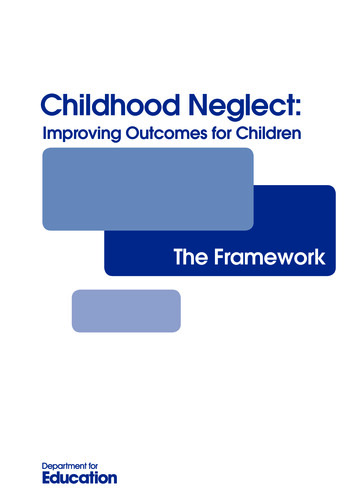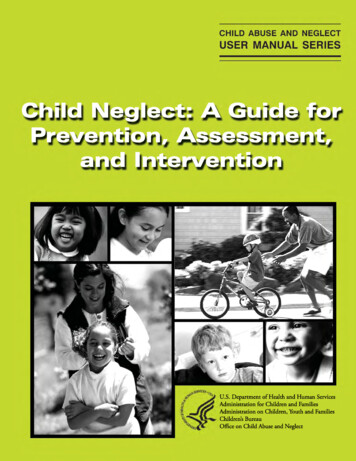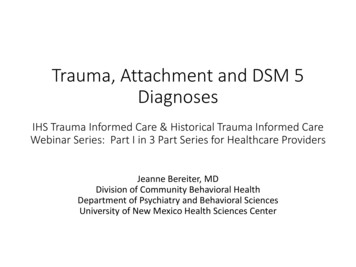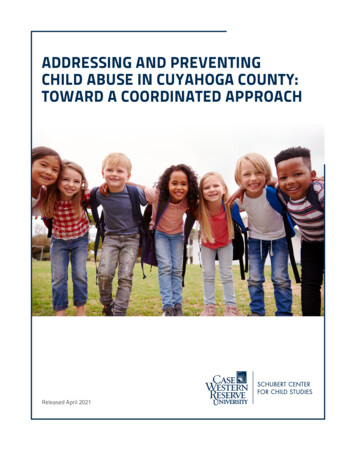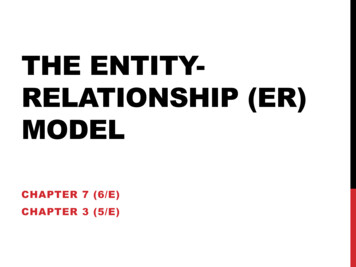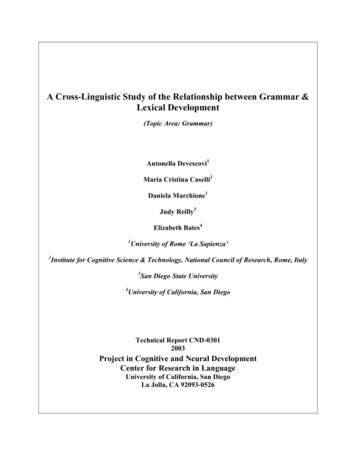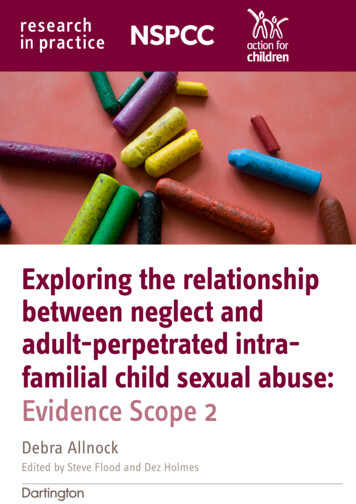
Transcription
Research in Practice NSPCC Action for ChildrenExploring the relationshipbetween neglect andadult-perpetrated intrafamilial child sexual abuse:Evidence Scope 2Debra AllnockEdited by Steve Flood and Dez Holmes
Research in Practice NSPCC Action for ChildrenSection 1: IntroductionThis scope aims to explore the relationship betweenneglect and intra-familial child sexual abuse (IFCSA).Current approaches to the study of child abuse and neglectincreasingly highlight the weaknesses in solely focusingon single forms of harm in understanding prevention,identification, impact and overcoming maltreatment andvictimisation. While not all children experience multipleforms of harm, the recent literature clustered under areasof study such as ‘poly-victimisation’ (Finkelhor, Ormrodand Turner, 2007), multiple adversities (Davidson, Buntingand Webb, 2012), adverse childhood experiences1, multitype maltreatment (Higgins and McCabe, 2001) andrevictimisation (Classen, Palesh and Aggarwal, 2005) drawattention to the cumulative nature of harm for a significantgroup of other children and young people. Researchers inthese areas assert the importance of understanding thefull victimisation profiles of children and young peoplein order to address the cumulative impacts of harmcomprehensively. This literature has importantly highlightedthe complexity of children’s victimisation but is in the earlyphases of describing the factors that may explain thesecomplex experiences.Neglect is one of the most common forms of childmaltreatment. In England 43% of child protection plansare initiated in response to identified neglect (Departmentfor Education, 2015a) and in other UK nations neglect isthe most common reason for children being on the childprotection register (Jütte et al, 2015)2. Cases recorded inchild protection systems are likely to be merely the tipof the iceberg, however; many more cases fall below thethreshold for criminal intervention (Dickens, 2007) andRadford et al’s general population study (2011) foundneglect was the most common form of maltreatmentreported within the family. The most recent triennial reviewof serious case reviews (SCRs)3 found that, of the 175 SCRsreviewed in detail, neglect was a factor in 62% of all casesof non-fatal harm and in 52% of cases where a child haddied (Sidebotham et al, 2016). Despite its significance,neglect is one of the least researched areas of maltreatment(see Allnock, forthcoming; Stoltenborgh, BakermansKranenburg and van IJzendoorn, 2013; Stoltenborghet al, 2015). Oral evidence submitted to the Children’s1See Centers for Disease Control and /index.html2Scotland still maintains Child Protection Registers (see The ScottishGovernment’s National Guidance for Child Protection in Scotland 2014for detail); as does Wales (see Welsh Government, Local Authority ChildProtection Registers 2015).Commissioner’s Inquiry into Child Sexual Abuse in theFamily Environment suggests there may be considerablenumbers of children who are identified as experiencingneglect where there are additional concerns around sexualabuse in the family environment (Children’s Commissioner,2015).It is imperative, then, to think critically about the overlapbetween neglect and IFCSA and to ask questions of ourpractice and policy in this regard. Although the evidenceis complex, and in some cases lacking altogether, it isimportant to understand co-occurrence and to think aboutways of supporting families to ensure that perpetrators findfewer opportunities to target and abuse children.The scope’s areas of focus and structureThis scope is the second of three linked evidence scopescommissioned by Action for Children and the NationalSociety for the Prevention of Cruelty to Children (NSPCC)with Research in Practice. Scope 1 considers the potentialrelationship between neglect and child sexual exploitation(CSE) (Hanson, 2016); Scope 3 considers the potentialrelationship between neglect and harmful sexualbehaviours (Hackett, 2016).This scope explores three key questions:1) Do neglect and intra-familial child sexual abuse cooccur? And if so, to what extent?2) How might features, types and impacts of neglectincrease the vulnerability of children and youngpeople to perpetrator methods of targeting,grooming, abusing and silencing children in thefamily environment?3) How might IFCSA contribute to neglect?The focus on neglect and IFCSA in this scope does notseek to locate blame for IFCSA within individual parents(and in particular mothers, which is too often the casein the discourse about neglect) and within parentingstyles/behaviours (particularly mothers’ parenting styles/behaviours). Such an approach would deflect responsibilityaway from the perpetrator, without whom there would beno abuse in the first place. Moreover, focusing on individualparents (mothers) would be at the expense of recognisingthe wider social determinants of neglect, including the‘wide range of adverse experiences’ associated with whatHooper et al (2006) call ‘societal neglect’. These points willbe returned to in more detail later in the scope.3A serious case review (in England) occurs when a child has died or isseriously injured and neglect or abuse is suspected. It looks at lessons that can be learned to prevent similar cases from happening inthe future. Other UK nations have their own systems in place to learnfrom these types of case: in Wales they are called practice reviews, inNorthern Ireland case management reviews, and in Scotland significant case reviews. See the NSPCC website for more xploring the relationship between neglect and adult-perpetrated intra-familial child sexual abuse: Evidence Scope 22
Research in Practice NSPCC Action for ChildrenAdditional points to note in relation to this scope include: The focus of this scope is on concurrent experiencesof neglect and IFCSA. (Scope 1 focuses on therelationship with neglect and additional separateforms of victimisation through CSE.) The focus of this scope is on adult-perpetratedIFCSA. (Scope 3 focuses on the relationshipbetween neglect and harmful sexual behavioursin children and young people, touching briefly onsibling-abuse.) There is particular emphasis on the specificemotional harm associated with betrayal by aparent, guardian or other family member. This iswhy the focus of this scope is on the relationshipwith the perpetrator, rather than the setting inwhich abuse takes place. The scope focuses on concurrent experiencesof neglect and IFCSA across childhood toadolescence, recognising that neither IFCSA norneglect is confined to early childhood. This scope is not intended to be an exhaustivereview of the literature; rather it is intended tobegin to interrogate these associations and raisequestions where relevant about the nature of theseforms of harm.Constraints of the current evidence baseVery few (almost no) studies were identified thatspecifically considered neglect and IFCSA. There are alsoother important limitations to the research evidenceconsidered for this scope (these are described more fullyin Appendix A). First, there are very few prospectivelongitudinal studies4 on child maltreatment, either in theUK or abroad, and it is these that would provide the bestevidence for a link between neglect and IFCSA. Second,despite neglect being the most commonly reported form ofmaltreatment, research on CSA is far more prevalent thanon neglect.Third, research studies have historically focused onone form of abuse only; while studies acknowledgingoverlapping forms of abuse and adversity are nowemerging, this remains an early field of study. Finally,studies on neglect and CSA use varying definitions andmeasurements of neglect, which makes it difficult to drawcomparisons,5 and studies commonly do not distinguishbetween IFCSA and other forms of CSA.Despite these limitations, however, there is enoughinformation in the separate literature bases (on neglect andCSA) to begin some commentary on possible ways in whichneglect may increase a child’s vulnerability to IFCSA, andhow IFCSA might contribute to increased risk of neglect.4A longitudinal study is one in which the study of participants isrepeated over time, usually over many years. The prospective studyis important for research on the etiology of outcomes (often diseasesand disorders, but prospective studies of maltreatment exist also).The distinguishing feature of a prospective cohort study is thatwhen investigators enrol participants and begin collecting baselineinformation, none of the subjects has experienced any of the outcomesof interest (in maltreatment research, these studies are often interestedin long-term outcomes such as mental and physical health effects).After baseline information is collected, participants are followed‘longitudinally’ – ie, over a period of time, usually for years – todetermine if and when they exhibit the outcomes of interest and whethertheir exposure status (to maltreatment) changes outcomes. In this way,investigators can eventually use the data to answer many questionsabout the associations between ‘risk factors’ and long-term outcomes.For example, see the discussion in Taylor, Daniel and Scott (2012); seealso Radford et al (2011)5Exploring the relationship between neglect and adult-perpetrated intra-familial child sexual abuse: Evidence Scope 23
Research in Practice NSPCC Action for ChildrenDefinitions and terminologySexual abuse‘Child maltreatment’ is used as an umbrella term in thisscope to refer to:According to Working Together (2015), child sexual abuse:All forms of physical and/or emotional ill-treatment, sexualabuse, neglect or negligent treatment or commercial or otherexploitation, resulting in actual or potential harm to the child’shealth, survival, development or dignity in the context of arelationship of responsibility, trust or power.(Butchart et al, 2006: p9)More specifically, the definitions of ‘neglect’ and ‘childsexual abuse’ (CSA) that guide this scope are drawn fromthe English statutory guidance Working Together to SafeguardChildren (HM Government, 2015), which are also reflected inthe World Health Organisation definition above.While definitions of neglect and CSA differ slightly acrossEngland, Northern Ireland, Scotland and Wales (these can becompared in Appendix B), most messages in this scope arelikely to be transferrable across jurisdictions. Readers shouldapply the messages to the relevant legislation, policy andpractice in their own locale.NeglectNeglect is usually considered to be the omission of specificbehaviours by caregivers (often without the intention toharm), rather than acts of commission as is characteristic ofother forms of maltreatment such as sexual and physicalabuse (Connell-Carrick, 2003). Neglect can include actsof commission however, such as forcing a young personto leave home before they are ready. Neglect is defined inWorking Together (2015) as:The persistent failure to meet a child’s basic physical and/orpsychological needs, likely to result in the serious impairment ofthe child’s health or development. (HM Government, 2015: p93)The Welsh Government (through the Social Services andWell-being (Wales) Act 20146) has recently removed thereference to ‘persistence’, as has the government of NorthernIreland in its revised guidance issued in March 2016; theEnglish and Scottish definitions still contain this reference,however (see Appendix B for the full definitions that applyin all four countries). All definitions reference physical,emotional, nutritional, supervisory and medical neglect,although the wider literature also recognises educationalneglect (Horwath, 2007; Moran, 2010). (Appendix C sets outthe types of neglect and their associated features.)Defining neglect is contentious, but the approach adopted inEngland and other parts of the UK defines neglect in termsof its likelihood of significant harm or impairment to thechild’s development (as opposed to whether there has beenactual harm) (Brandon et al, 2014).Available at: cted.Statutory guidance (Safeguarding Children: Working Together under theChildren Act 2004) is currently being updated and will reflect the newlegal definition.6Involves forcing or enticing a child or young person to takepart in sexual activities, not necessarily involving a highlevel of violence, whether or not the child is aware of what ishappening. (HM Government, 2015: p93)This statutory definition covers all forms of child sexualabuse, includes a continuum of acts (contact, non-contact),makes broad reference to setting (online versus offline)and recognises that females and children/peers may alsocommit abuse. (See Appendix B for the full definition.)Child sexual exploitation (CSE) is a form of child sexualabuse (see Scope 1 for more on the definition of CSE).Intra-familial child sexual abuse (IFCSA)There is no statutory definition for intra-familial childsexual abuse. Horvath and colleagues carried out a RapidEvidence Assessment (REA) on IFCSA for the Children’sCommissioner in England, in which IFCSA (also referred toin the report as CSA in the family environment) was definedas:Child sexual abuse perpetrated by a family member or thattakes place within a family context or environment, whetheror not by a family member. (Horvath et al, 2014: p9)This broad definition reflects the Crown Prosecution Serviceguidelines on the Sexual Offences Act 2003, which states:These offences reflect the modern family unit and takeaccount of situations where someone is living within the samehousehold as a child and assuming a position of trust orauthority over that child, as well as relationships defined byblood ties, adoption, fostering, marriage or living together aspartners. (Crown Prosecution Service7)The Children’s Commissioner’s recent Inquiry into SexualAbuse in the Family Environment (which followed on fromHorvath et al’s REA described above) used the followingdefinition: sexual abuse perpetrated or facilitated in or out of thehome, against a child under the age of 18, by a familymember, or someone otherwise linked to the family contextor environment, whether or not they are a family member.Within this definition, perpetrators may be close to the victim(e.g. father, uncle, stepfather), or less familiar (e.g. familyfriend, babysitter). (Children’s Commissioner, 2015; p6)7Crown Prosecution Service legal guidance: Rape and Sexual Offences,Chapter 2: Sexual Offences Act, 2003. Available at: www.cps.gov.uk/legal/p to r/rape and sexual offences/soa 2003 and soa 1956Exploring the relationship between neglect and adult-perpetrated intra-familial child sexual abuse: Evidence Scope 24
Research in Practice NSPCC Action for ChildrenThese definitions recognise the wide range of IFCSAperpetrators, including biological and non-biologicalfamily members such as parents, step-parents, siblings,step-siblings, cousins, grandparents, aunts and unclesand nephews and nieces. For the purpose of this scope,however, a more narrow definition was applied:The sexual abuse of a child by an adult in a familial setting.The rationale for this limited definition was: To distinguish between abuse perpetrated bya responsible adult in the family setting fromharmful sexual behaviours (HSB) exhibitedand/or perpetrated by a child in the familyenvironment (which is touched on briefly inScope 3). To distinguish between adult abuse andexploitation perpetrated within the home fromthat which occurs outside of the family (someof which will be addressed in Scope 1) To recognise the particular emotional impactsrelated to betrayal of trust that is associatedwith sexual abuse by an adult in the context ofa familial setting.The definition used in this scope does not limit familialrelationships to biological ties, recognising that unrelatedadults may be residing or spending time within thechild’s home environment. There are some limitationsin using this constrained definition, however, in that itdid not always align with IFCSA definitions in the studiesconsulted, which themselves used a wide variety ofdefinitions of IFCSA (Horvath et al, 2014).Exploring the relationship between neglect and adult-perpetrated intra-familial child sexual abuse: Evidence Scope 25
Research in Practice NSPCC Action for ChildrenSection 2: The scale of neglect and intrafamilial child sexual abuseKnowledge about the scale of maltreatment in the UKcomes from three specific sources:1) recorded offences2) child protection systems3) self-report studies.All have their limitations, for example, recorded offencesand child protection data reflect only those cases that cometo the attention of the police or children’s social care; selfreport sources, such as ChildLine, include only children andyoung people who decide to seek help through that route.Self-report studies such as large-scale prevalence studiesprovide a somewhat broader picture because they allowaccess to the general population, including childrenand young people unknown to the police or social care.Importantly, they also highlight the large gap betweenthose known to the authorities and the wider populationwho may not report abuse or neglect (Gilbert et al, 2008).However, experts agree that even self-report prevalencestudies underestimate abuse and maltreatment becausechildren, young people and even adults abused inchildhood may not report their experiences within aresearch setting, for a variety of reasons (Radford etal, 2011). Some individuals may not recognise theseexperiences as abuse or maltreatment; others may feardisclosing if the perpetrator still lives in the household;they may fear not being believed; and some respondentsmay be reluctant to disclose because of shame, stigma,guilt or fear of the perpetrator, or because of negativeexperiences following previous disclosure (Allnock andMiller, 2013).NeglectIn all four countries of the UK, neglect is consistently citedas the most common reason for children to be the subjectof a child protection plan or on a child protection register(Jütte et al, 2015). In England in 2014-15, 43% of all childprotection plans were initiated in response to neglect (DfE,2015). There were 7,726 recorded offences for cruelty tochildren in 2013-14 – a rate of 7.6 per 10,000 children agedunder 16, the highest it has been in a decade (Jütte et al,2015). However, many more cases of neglect fall below thethreshold for criminal intervention (Dickens, 2007).The prevalence of neglect in the UK is best captured byRadford et al’s (2011) study Child Abuse and Neglect in theUK Today, a general population study of 6,000 participantsacross three groups: 2,160 parents or guardians of children under age 11 2,275 young people aged 11 to 17 1,761 young adults aged 18 to 24.The study found that neglect was the most common formof child maltreatment reported in the family, 5% of parentsor guardians of children under age 11 reported neglect(3.7% reported severe neglect); 13.3% of 11 to 17-year-oldsreported neglect (9.8% reported severe neglect); and 16%of 18 to 24-year-olds reported neglect in childhood (9%reported severe neglect). Boys and girls report relativelyequal rates of neglect (Radford et al, 2011; Stoltenborgh,Bakermans-Kranenburg and van IJzendoorn, 2013); Radfordet al found the largest disparities were among 11 to 17-yearolds (14.8% of boys and 11.8% of girls said they hadexperienced neglect) and reports of severe neglect among18 to 24-year-olds (11% of girls and 7% of boys).Neglect occurs across childhood and adolescence (Steinet al, 2009; Daniel, Burgess and Scott, 2012). The mostrecent national analyses of serious case reviews inEngland (Sidebotham et al, 2016; Brandon et al, 2013) havedemonstrated that neglect features across all age ranges.Radford et al (2011) also found that neglect is reportedacross age ranges. Past year rates of maltreatment providea window into recent experiences, and Radford et al (2011)found that older children reported higher past year rates ofmaltreatment than younger children. The authors note that:Although it is known that babies and young children haveparticular child protection needs due to their vulnerabilityand dependence upon adults, these findings show theimportance of addressing the particular age-specific childprotection needs of older children and teenagers.(Radford et al, 2011: p42)Exploring the relationship between neglect and adult-perpetrated intra-familial child sexual abuse: Evidence Scope 26
Research in Practice NSPCC Action for ChildrenBrandon and colleagues (2014) point to a number reasonswhy neglect may be difficult to identify and respond to: Professionals may become accustomed to thechronic nature of neglect.Neglect relatively rarely manifests in a crisisthat demands immediate action.Professionals need to look beyond individualparenting episodes to understand neglect incontext.Professionals may also be reluctant to makejudgements about parenting, particularlywhere there are cultural underpinnings andwhere poverty may be a contributory factor.Neglect may be experienced alongside otherforms of abuse that make it difficult to identify.The scale of IFCSAThe Radford et al (2011) study tells us a little aboutintra-familial child sexual abuse. For example, weknow that: Sexual abuseNearly 5% (2,870) of child protection plans in Englandwere initiated in response to sexual abuse during 2014-15(DfE, 2015) and an additional 8% were made for ‘multiple’categories of abuse (it is unknown how much of this mightbe for sexual abuse). Reporting of both recent and nonrecent sexual offences has been increasing for some yearsfollowing the public revelations of widespread abuse byJimmy Savile (HMIC, 2013). In England and Wales, therewere 88,219 police recorded sexual offences in the yearending March 2015, an increase of 37% compared with theprevious year (ONS, 2015). This is the highest figure everrecorded by the police and the largest annual percentageincrease since the introduction of the National CrimeRecording Standard in April 2002. Within this, all sexualoffences against children show upward trends in reporting,with highest increases identified in the categories of‘sexual grooming’ and ‘sexual activity with a child under13’. Unfortunately, these figures do not distinguish betweenIFCSA and abuse perpetrated outside of the family.In Radford et al’s study, the lifetime prevalence of contactand non-contact sexual abuse – by any adult or peerperpetrator – experienced under the age of 18 (as reportedby the 18 to 24-year-olds) was 24.1%; 16.5% for the 11 to17-year-olds; and parents/carers of under-11s reported alifetime rate of 1.2% for their children. When consideringcontact sexual abuse only, the figures are 12.5% for the 18to 24 age group; 5.1% for the 11 to 17s; and 0.5% reportedby parents/carers of the under-11s (Radford et al, 2013).(The full range of findings relating sexual abuse canbe found in the main report – see Radford et al, 2011.)Although few studies fully disaggregate rates of intrafamilial and extra-familial CSA (EFCSA), Radford et al’sstudy presents some key findings related to IFCSA, withlimitations. 1.0% of 18 to 24-year-olds (1.5% of girls,0.6% of boys) reported sexual abuse (contactand non-contact) perpetrated by a parentor guardian. Among 11 to 17-year-olds,0.1% reported sexual abuse by a parent orguardian; a rate of 0.1% was also reportedby parents/guardians of under-11s. (Abuseagainst males was only reported by 18 to24-year-olds; the remainder of reportedabuse was against females.)0.9% of all reported contact sexual abusewas perpetrated by a parent or guardian.None of the 11 to 17-year-olds, and noneof the parent/guardian responders for theunder-11s, reported sexual abuse by a parentor guardian in the past year.The study also reported the prevalence of sexual abuseperpetrated by non-resident adult relatives. The findingsinclude that: 0.1% of under-11s, 0.2% of 11-17s and 0.8% of18 to 24-year-olds reported sexual abuse by anon-resident adult relative.Of all non-resident adults, non-residentrelatives were reported to be the leastcommon perpetrators of sexual abuse.(Strangers were most common, followed byneighbours or family friends not living in thefamily home.)The study does not provide more detail onother resident adults living in the family home.The figures above are in line with other studies, includingan earlier study by the NSPCC (Cawson et al, 2000), inwhich 1% or less of respondents reported contact andnon-contact CSA by parents or guardians. An internationalreview of child maltreatment in the Nordic countries foundsimilar low rates of IFCSA (Kloppen et al, 2015). It wasnotable that the authors could not make internationalcomparisons of IFCSA with their Nordic findings becauseso few studies disentangle IFCSA from abuse occurringoutside the family.Exploring the relationship between neglect and adult-perpetrated intra-familial child sexual abuse: Evidence Scope 27
Research in Practice NSPCC Action for ChildrenSome research finds that a close relationship – such asa familial relationship – between child and perpetratornegatively impacts on disclosure (Ussher and Dewberry,1995; Priebe and Svedin, 2008), although the research is byno means unequivocal (London et al, 2008). Children maybe particularly unlikely to report abuse by a family memberif the perpetrator is living in the household – this maybe why there are no past year rates of CSA by a parent orguardian reported in Radford et al’s (2011) study.Like neglect, IFCSA occurs across childhood andadolescence, although it generally appears to occur atyounger ages than extra-familial CSA (EFCSA) (Fischer andMcDonald, 1998). Smith, Dogaru and Ellis (2015) foundthat 70% of a sample of 398 adult survivors of CSA hadexperienced IFCSA. While the study was not representativeof the broader population of survivors (the sample wasskewed towards IFCSA experiences), abuse had startedbefore the age of 11 for 78.5% of participants; for one infive (19.5%) participants, abuse began between 11 and15, although this could comprise mostly EFCSA – it is notpossible to tell from the published statistics. Supportiveof this finding, however, are findings from the Children’sCommissioner of England’s survey of adult survivors ofintra-familial CSA, 60% of whom reported that abusestarted before the age of 9 (Children’s Commissioner,2015: 45). Some qualitative studies report that IFCSA cancontinue over many years, even into adulthood (Allnockand Miller, 2013; Middleton, 2013).Summary of key pointsAlthough prevalence studies and other statistics onchild protection are considered under-representative ofchildren and young people’s reality, the figures reportedhere indicate that neglect remains the most commonlyreported form of maltreatment in the family, whichunderpins the importance of considered attention tothis form of harm. IFCSA by parents or guardians inaddition to related adults not living in the family homeappears to occur at relatively low rates, which couldlead some readers to conclude that IFCSA is insignificantin comparison to abuse perpetrated by other peopleand therefore not something requiring resources andattention. However, it would be erroneous to makesuch an assumption given the well-recognised patternof under-reporting of abuse by children and youngpeople. Under-reporting may be particularly relevant inthe context of IFCSA where the perpetrator has a closerelationship with the child.Key points Across the UK, neglect is consistently cited asthe most common reason for children to be thesubject of a child protection plan or on a childprotection register. Neglect occurs across childhoodand adolescence, though manifestations can varyaccording to a child’s developmental stage. Boysand girls appear to be equally affected. Despite it being the most common form ofmaltreatment, practitioners can find neglect bothhard to identify and respond to. IFCSA occurs across childhood and adolescence,although it generally appears to occur at youngerages than EFCSA. Prevalence studies suggest thatIFCSA by parents, guardians and other familymembers occurs at relatively low rates. These ratesare likely to reflect some level of under-reporting,however.Exploring the relationship between neglect and child sexual exploitation: An evidence scope8
Research in Practice NSPCC Action for ChildrenSection 3: The impacts of neglect andintra-familial child sexual abuseThis section briefly outlines what is known about theimpacts of neglect and IFCSA across the life course in orderto – in later sections - consider whether some impacts mayincrease the vulnerability of children to other forms of harmaround them, specifically IFCSA.NeglectHow do children perceive neglect?A study by the University of Stirling, commissioned byAction for Children (Burgess et al, 2014)Researchers surveyed 1,582 children and provided themwith a list of known indicators of neglect. They askedchildren to tell them if they’d ever known children whohad experienced any of the indicators. Three-quarterssaid they recognised at least one of the indicatorspresented, including other children who frequently missschool, who have few friends (at school or home), whoseparents don’t seem to know where their child is or whatthey’re doing, whose clothes may not fit or may be oldor smell bad, children who look unwashed or are oftendirty, or who might say they don’t get meals at home.The researchers also talked directly to some childrenand found they could describe, often in powerful ways,what it feels like to be neglected. Children spoke of theemotional toll neglect can take, including never beinghugged, not getting loved and being left at home alone.They said neglected children can find themselves gettinginto trouble with the police. And some described feelingsof social isolation and exclusion, and fee
emotional, nutritional, supervisory and medical neglect, although the wider literature also recognises educational neglect (Horwath, 2007; Moran, 2010). (Appendix C sets out the types of neglect and their associated features.) Defining neglect is contentious, but the approach adopted in England and other parts of the UK defines neglect in terms

